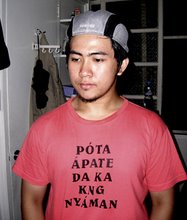Urban Kamaru
Central Luzon Daily
Sino manga tao nga Cuyonon?
There are many ethnolinguistic groups in the Philippines, but we know only the major ones such as the Tagalogs, Cebuanos, Ilonggos, Kapampangans, Ilocanos, Bicolanos, Pangasinenses, Warays, and to some extent, the Tausugs, Badjaos, Maranaos, and Maguindanaos. For us Luzonians, the Cuyonon people are most of the time unheard of. However, if we have seen the movie “Ploning” starring Judy Ann Santos, we might have an idea about the Cuyonon people of Cuyo Island of the Palawan province and the Western Visayan language that they usually speak.

Surprisingly, I actually knew people in Angeles City of Cuyonon descent. JC Lim, a high school classmate of mine at the Chevalier School, along with his big brother Vincent Lim, who became the Valedictorian of his batch in the same school, have a Cuyonon mother. Their identification of themselves back when I often encountered them in the city has always been either Chinese or Kapampangan though.
In our production trip to Puerto Princesa City weeks ago, we got to know more about the Cuyonons—although there is still much to know about them. But in a span of a week, we were able to discover things about them that might interest us Kapampangans, especially those engaged in cultural work and literature.
The Letter H
Dorong dagon den ang ag lolobas Ang adlao na ikaw mabagat ko Indi ko pa ra engued malipatan Imong matang midyo biton sa langit Imong mga ngirit indi agpakatorog Pirmi ko ing sasadyap imong mga arek
This is a stanza from the song “Ploning Adin Ka Ren” (Ploning, Where Art Thou) by Bulyaw Mariguen, a rock band that makes contemporary Cuyonon songs. The shooting of the music video of the song was our purpose in flying there. Do you notice anything about the stanzas and the Cuyonon language?
In one of our idle sessions, Engr. Johnny Fabello, who is the owner of the house were were lodging in and the father of the executive producer of the music video, told us, “Suwerte kayong mga Kapampangan, immune kayo sa swine flu.”
When we asked why, he comically replied, “Kasi wala kayong H!” referring to the presence of the letter H in H1N1. Apparently he knew about the infamous Kapampangan stereotype of H-deficiency in speech.
After laughing with his joke, I responded, “E di kayo rin po, immune din kayo? Wala rin po kasi kayong H.” He paused for a moment to think about it... no, they do not have the letter H either! And we found it amusing that they, despite being Cuyonon speaker, never noticed. Take for example the following Cuyonon words, their Tagalog counterparts, and their lack of H.
“Indi” for “hindi,” “arek” for “halik,” “kasiguraduan” for “kasiguraduhan,” and “kabui” for “buhay” (“buhi” in several Visayan languages).
But since Kapampangans are a major language group—the seventh biggest ethnolinguistic group in the country, with around two million native speakers, versus the Cuyonon speakers who are only approximately a hundred thousand—we have earned the dunce hat of H-deficiency in the world of stereotypes.
Enam, Anem, Anam, Anim
In Kapampangan, the rootword “atas” (height), when turned into an adjective, becomes “mátas,” because the prefix “ma-” is added. It's a general rule in Kapampangan to drop the 'a' from “ma-” (or “ka-”) thus making it “mátas,” not “maatas” or “mayatas.”
The same goes for the following words: “máyap/káyap” (not “maayap”), “maslam/kaslam” (not “maaslam”), “málimum” (not “maalimum”) and “málat” (not “mayalat” or “maalat”).
It's the same for Cuyonon. “Mayad” (good) is “ma-” and “ayad” combined, but the sum is only “mayad,” with stress on the last syllable.
Unlike Tagalog and Kapampangan, Cuyonon can have glottal stops in the middle of their sentences like the Cebuano speakers. This glottal stop is written in the symbol of an apostrophe. However, fast speech can conceal the glottal stop in the middle of Cuyonon sentences.
A last observation we had was regarding the way they pronounce the letter E. It's not like how we say the letter E in Kapampangan words like “sukle,” “betute,” and “eran.” It's more like the way Bahasa Indonesia/Melayu speakers pronounce the letter E—like an “uh” sound—making the Indonesian word “setelah” read as “suh-tuh-lá” and “lelaki” as “luh-lá-kee.” Therefore, in Cuyonon, “gegma” (love) is read as “guhg-má” and “aken” as “áh-kuhn.”
With this characteristic of Cuyonon, it makes some words sound like they're Kapampangan. The Kapampangan “anam” (six), even though it has two letter As written the same way, the first A is actually longer compared to the A in the second syllable. Its pronunciation is “ah-nuhm.” In Cuyonon, the number six is “anem.” With what we've discussed with the Cuyonon E sound, can you now try to read “anem”?
CQ vs K Dispute
Since Cuyonon is not a national or official language, no group or institution has the authority to dictate how the Cuyonon language should be written.
The older generation, like those from Cuyonon.org, are advocating for the use of the CQ orthography—just like how the older generation of Kapampangans insist on CQ—because, according to them, “the letter K is not Cuyonon,” just as how confused Kapampangan elders would reason, “the letter K is not Capampangan.”
The younger generation goes for the K orthography though, because of their Abakada education, and find it more efficient to write because instead of having two symbols for one sound such as C and Q for the “k” sound and C and S for the “s,” they only need one.
Pursuant to the Ordinances
In Pampanga, the Governor has declared an “Aldo Ning Amanung Sisuan” to be celebrated on the last Friday of August, the Languages Month, and had formed a Pampanga Provincial Language Council to spearhead events that would promote the use of the Kapampangan language. Language advocates rejoiced with the declaration, because they have begun to notice that Kapampangan children born to Kapampangan parents are gradually being turned into native Tagalog speakers with no knowledge or understanding of Kapampangan.
A similar case can be seen with the Cuyonons. Years ago, the Vice Governor of Palawan authored an ordinance they called the Cuyonon Provincial Dialect Ordinance (albeit they got it wrong calling Cuyonon a dialect instead of a language). Cuyonon was declared the “Official Dialect” of the Palawan province; a committee had been designated to work on its function of promoting Cuyonon language, literature, traditions, and culture, and institutions were encouraged to take part in the movement to counter the case of Tagalog-speaking Cuyonon children born to Cuyonon parents.
Because Palawan must be one of the most linguistically diverse provinces in the Philippines, Tagalog has often served as the lingua franca of the dwellers. Its reputation as tourist destination must also contribute to the interest of the natives in learning the outsiders' languages. However, hints of the struggling dominance of Cuyonon in Palawan is evident—aside from the provincial ordinance supporting its promotion—is evident in the penetration of the Cuyonon language in FM and AM radio stations such as DYPR and DYER and cable television. The Philippine Airlines also acknowledges Cuyonon as the dominant native language of Palawan, as it uses the Cuyonon language in some of its greetings and announcements in domestic flights taken in Puerto Princesa.
Pampanga, although diverse in its own right due to the in-migration of Visayans, Maranaos, Koreans, Aytas, Tagalogs, Ilocanos, Pangasinenses, and Ilocanos, is still acknowledged to be a Kapampangan-speaking area, and Kapampangan continuously penetrates various forms of mass and interactive media.

Now back to the ordinances—laudable declarations, I must say. But the question is: how well-implemented are these ordinances and the activities spearheaded by the designated councils? Are they even effective in promoting the local language especially to the modern youth?
Or do the celebrations just come and go, creating the illusion that the local language is being saved?
That we'll have to see.
















